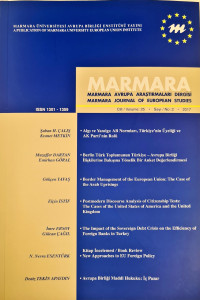AVRUPA BİRLİĞİ’NİN SINIR YÖNETİMİ: ARAP AYAKLANMALARI ÖRNEĞİ
Öz
2010’da başlayan Arap Ayaklanmalarıyla birlikte Avrupa Birliği ortaya çıkan büyük ölçüdeki insani kriz için– özellikle Orta Doğu ve Kuzey Afrika bölgesinden AB topraklarına doğru olan göç akımını önlemek amacıyla- acil bir çözüm aramıştır. Bu ölçüde, öncelikle Birlik dış sınırlarının yönetimi için ilave adımlar atmıştır. Bu çalışmanın amacı, Foucault’un yönetimsellik anlayışı referans alınarak AB’nin 2011 ve 2016 yılları arasında göçmenlere, mültecilere ve üçüncü ülkelere yönelik uyguladığı sınır yönetimini incelemektir. Bu çalışmada, AB’nin, sınır yönetimi politikalarını ve uygulamalarını AB ile göçmen ve mülteci nüfusu arasındaki güç ilişkileri üzerine yapılandırdığı tartışılmaktadır. AB’nin liberal yönetim teknolojileri üzerine odaklanan sınır yönetimi politikaları iki düzeyde incelenmektedir: Birincisi, AB’nin söz konusu nüfuslara yönelik, kök nedenlere işaret eden ve çoğunlukla ekonomik, siyasi ve kalkınma politikalarını içeren düzenlemeleridir. İkincisi, AB’nin sınır bölgelerindeki mülteci ve göçmenlere yönelik sürdürdüğü politikalarıdır. Bu politikalar ve uygulamalar yönetimselliğin biyopolitik yapıları bakımından değerlendirilmektedir.
Anahtar Kelimeler
Avrupa Birliği sınır yönetimi göçmenler mülteciler yönetimsellik
Kaynakça
- Basaran, T. (2008) “Security, Law, Borders: Spaces of Exclusion”, International Political Sociology, 2: 339-354.
- Bauer, P. (2013) “European–Mediterranean Security and the Arab Spring: Changes and Challenges”, Democracy and Security, 9 (1-2): 1-18.
- BBC News (2016) “Migrant Crisis: Migration to Europe explained in seven charts”, 4 March 2016, <http://www.bbc.co.uk/news/world-europe-34131911>, (27 November 2017).
- Bigo, D. (2002) “Security and Immigration Towards a Critique of the Governmentality of Unease”, Alternatives, 27: 63-92.
- Bigo, D. (2008) “Security: A Field Left Fallow”, in M. Dillon and A.W. Neal (eds), Foucault on Politics, Security and War, (Basingstoke: Palgrave Macmillan), pp.93-11.
- Bigo, D. (2011) “Freedom and Speech in Enlarged Borderzones” in V. Squire (ed.), The Contested Politics of Mobility, (Oxon: Routledge), pp. 31-50.
- Bourbeau, P. (2011) The Securitization of Migration: A Study of Movement and Order, (London: Routledge).
- Carrera, S. (2007) “The EU Border Management Strategy, FRONTEX and the Challenges of Irregular Immigration in the Canary Islands”, CEPS Working Document No.261, March, <https://www.ceps.eu/publications/eu-border-management-strategy-frontex-and-challenges-irregular-immigration-canary>, (28 November 2017).
- Carrera, S., Blockmans, S., Cassarino, J.P., Gross, D. and Guild, D. (2017) “The European Border Coast Guard, Addressing Migration and Asylum Challenges in the Mediterranean?”, CEPS Task Force Report, < https://www.ceps.eu/system/files/TFR%20EU%20Border%20and%20Coast%20Guard%20with%20cover_0.pdf>, (23 November 2017).
- Cassarino, J.P. (2012) “Reversing the Hierarchy of Priorities in EU-Mediterranean Relations”, in J. Peters (ed), The European Union and the Arab Spring, (Lanham, Boulder, New York, Toronto, Plymouth, UK: Lexington Books), pp. 1-16.
Border Management of the European Union: The Case of the Arab Uprisings
Öz
With the outbreak of the Arab uprisings in 2010 the European Union has sought an urgent solution for the massive humanitarian crisis, particularly for preventing the migration flow from the Middle East and North Africa region to the EU territory. In this regard, the EU has taken further steps to manage the external borders of the Union. This study aims at examining the border management of the EU towards the immigrants and refugees and the third countries between 2011 and 2016 with reference to Foucault’s notion of governmentality. The study argues that the EU has built up its border management policies and practices along the lines of the power relations between the EU and immigrant and refugee populations. In the study, the border management centred on the technologies of liberal governmentality is analyzed in two interrelated levels: The first one is the EU’s regulation of human mobility including the economic, political and development policies and aiming at addressing the root causes of migration. The second one is the EU’s policies that are maintained at operational and technical levels towards the immigrants and refugees on the border zones. These policies and practices are examined with regard to the biopolitical structures of governmentality.
Anahtar Kelimeler
European Union border management immigrants refugees governmentality
Kaynakça
- Basaran, T. (2008) “Security, Law, Borders: Spaces of Exclusion”, International Political Sociology, 2: 339-354.
- Bauer, P. (2013) “European–Mediterranean Security and the Arab Spring: Changes and Challenges”, Democracy and Security, 9 (1-2): 1-18.
- BBC News (2016) “Migrant Crisis: Migration to Europe explained in seven charts”, 4 March 2016, <http://www.bbc.co.uk/news/world-europe-34131911>, (27 November 2017).
- Bigo, D. (2002) “Security and Immigration Towards a Critique of the Governmentality of Unease”, Alternatives, 27: 63-92.
- Bigo, D. (2008) “Security: A Field Left Fallow”, in M. Dillon and A.W. Neal (eds), Foucault on Politics, Security and War, (Basingstoke: Palgrave Macmillan), pp.93-11.
- Bigo, D. (2011) “Freedom and Speech in Enlarged Borderzones” in V. Squire (ed.), The Contested Politics of Mobility, (Oxon: Routledge), pp. 31-50.
- Bourbeau, P. (2011) The Securitization of Migration: A Study of Movement and Order, (London: Routledge).
- Carrera, S. (2007) “The EU Border Management Strategy, FRONTEX and the Challenges of Irregular Immigration in the Canary Islands”, CEPS Working Document No.261, March, <https://www.ceps.eu/publications/eu-border-management-strategy-frontex-and-challenges-irregular-immigration-canary>, (28 November 2017).
- Carrera, S., Blockmans, S., Cassarino, J.P., Gross, D. and Guild, D. (2017) “The European Border Coast Guard, Addressing Migration and Asylum Challenges in the Mediterranean?”, CEPS Task Force Report, < https://www.ceps.eu/system/files/TFR%20EU%20Border%20and%20Coast%20Guard%20with%20cover_0.pdf>, (23 November 2017).
- Cassarino, J.P. (2012) “Reversing the Hierarchy of Priorities in EU-Mediterranean Relations”, in J. Peters (ed), The European Union and the Arab Spring, (Lanham, Boulder, New York, Toronto, Plymouth, UK: Lexington Books), pp. 1-16.
Ayrıntılar
| Birincil Dil | Türkçe |
|---|---|
| Bölüm | Makaleler |
| Yazarlar | |
| Yayımlanma Tarihi | 27 Aralık 2017 |
| Yayımlandığı Sayı | Yıl 2017 Cilt: 25 Sayı: 2 |

